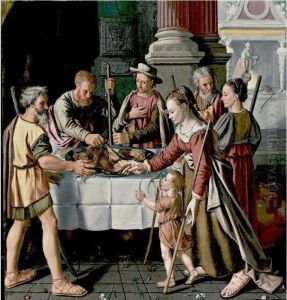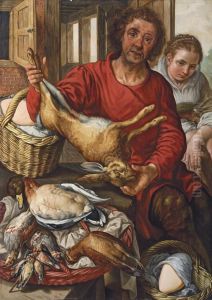Huybrecht Beuckelaer Paintings
Huybrecht Beuckelaer (sometimes spelled Joachim Beuckelaer) was an artist born in the mid-16th century in the Southern Netherlands, a region that corresponds to modern-day Belgium and parts of France and the Netherlands. While the exact year of his birth is not certain, it is often cited as between 1535 and 1540. He was a nephew and student of the well-known Flemish painter Pieter Aertsen, who had a significant influence on Beuckelaer’s work.
Beuckelaer specialized in market and kitchen scenes with elaborate displays of food and genre figures, which were popular in Northern Europe during the 16th century. He also painted religious scenes, often incorporating them into his market and kitchen compositions as background details. His work is characterized by its vivid detail, vibrant colors, and the skillful representation of textures and surfaces, which was innovative for the time and highlighted the abundance and variety of goods available in the burgeoning urban markets.
Although he was active during a period of religious and social upheaval, Beuckelaer’s works tended to focus on the secular and the everyday rather than the overtly political or religious. His paintings are considered to be an important contribution to the genre of still life and were influential in the development of this genre in the Low Countries.
Beuckelaer lived and worked in Antwerp, which was then one of the most important commercial and artistic centers in Europe. He was a contemporary of other significant Flemish artists, such as Pieter Bruegel the Elder. Despite his success and the popularity of his work during his lifetime, Beuckelaer’s name did not maintain the same level of recognition as some of his contemporaries in the centuries that followed.
The artist's death is similarly uncertain, with some sources suggesting that he died in 1605 and others suggesting as late as 1609. Today, Beuckelaer's paintings can be found in many major art museums around the world, providing a window into the culture and society of the 16th-century Netherlands.

